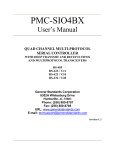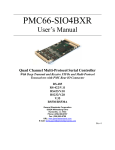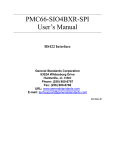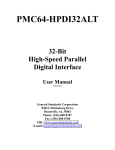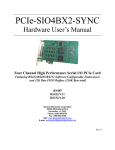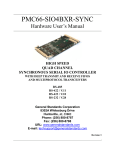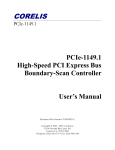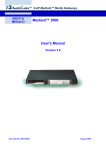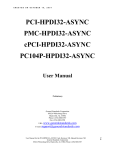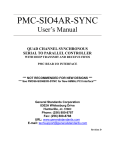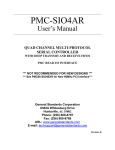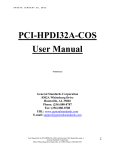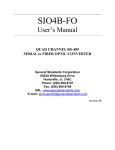Download PMC-SIO4BX-SYNC - General Standards Corporation
Transcript
PMC-SIO4BX-SYNC Hardware User’s Manual HIGH SPEED QUAD CHANNEL SYNCHRONOUS SERIAL IO CONTROLLER WITH DEEP TRANSMIT AND RECEIVE FIFOS AND MULTIPROTOCOL TRANSCEIVERS RS-485 RS-422 / V.11 RS-423 / V.10 RS-232 / V.28 General Standards Corporation 8302A Whitesburg Drive Huntsville, AL 35802 Phone: (256) 880-8787 Fax: (256) 880-8788 URL: www.generalstandards.com E-mail: [email protected] Revision E PREFACE Revision History 1. 2. 3. 4. 5. Rev A – Feb 2004 – Original rev from PCI-SIO4B manual. Rev B – Misc Updates Rev C – Aug 2004 - Misc Updates Rev D – Jun 2005 – update for v404 firmware Rev E – Nov 2007 – update for v40C firmware Additional copies of this manual or other General Standards Corporation literature may be obtained from: General Standards Corporation 8302A Whitesburg Drive Huntsville, Alabama 35802 Telephone: (256) 880-8787 Fax: (256) 880-8788 URL: www.generalstandards.com The information in this document is subject to change without notice. General Standards Corporation makes no warranty of any kind with regard to this material, including, but not limited to, the implied warranties of merchantability and fitness for a particular purpose. Although extensive editing and reviews are performed before release to ECO control, General Standards Corporation assumes no responsibility for any errors that may exist in this document. No commitment is made to update or keep current the information contained in this document. General Standards Corporation does not assume any liability arising out of the application or use of any product or circuit described herein, nor is any license conveyed under any patent right of any rights of others. General Standards Corporation assumes no responsibility resulting from omissions or errors in this manual, or from the use of information contained herein. General Standards Corporation reserves the right to make any changes, without notice, to this product to improve reliability, performance, function, or design. All rights reserved No parts of this document may be copied or reproduced in any form or by any means without prior written consent of General Standards Corporation. Copyright © 2007 General Standards Corporation RELATED PUBLICATIONS PLX PCI 9080 Data Book PLX Technology Inc. 390 Potrero Avenue Sunnyvale, CA 4085 (408) 774-3735 http://www.plxtech.com/ EIA-422-A – Electrical Characteristics of Balanced Voltage Digital Interface Circuits (EIA order number EIA-RS-422A) EIA-485 – Standard for Electrical Characteristics of Generators and Receivers for Use in Balanced Digital Multipoint Systems (EIA order number EIA-RS-485) EIA Standards and Publications can be purchased from: GLOBAL ENGINEERING DOCUMENTS 15 Inverness Way East Englewood, CO 80112 Phone: (800) 854-7179 http://global.ihs.com/ PCI Local Bus Specification Revision 2.1 June 1, 1995. Copies of PCI specifications available from: PCI Special Interest Group NE 2575 Kathryn Street, #17 Hillsboro, OR 97124 http://www.pcisig.com/ TABLE OF CONTENTS CHAPTER 1: INTRODUCTION .............................................................................................................................1 1 1.1 1.1.1 1.1.2 1.2 1.3 1.4 1.5 1.6 GENERAL DESCRIPTION..................................................................................................................................1 SERIAL INTERFACE .........................................................................................................................................2 THREE SIGNAL SERIAL INTERFACE.................................................................................................................2 TWO SIGNAL SERIAL INTERFACE....................................................................................................................3 DEEP TRANSMIT/RECEIVE FIFOS ...................................................................................................................3 MULTIPROTOCOL TRANSCEIVERS...................................................................................................................3 PMC/PCI INTERFACE .....................................................................................................................................3 GENERAL PURPOSE IO ...................................................................................................................................4 CONNECTOR INTERFACE.................................................................................................................................4 CHAPTER 2: LOCAL SPACE REGISTERS .........................................................................................................5 2 2.1 2.2 2.3 2.4 2.5 2.6 2.7 2.8 2.8.1 2.8.2 2.8.3 2.8.4 2.9 2.10 2.11 2.12 2.13 2.14 2.15 2.16 GSC FIRMWARE (LOCAL SPACE) REGISTERS .................................................................................................5 FIRMWARE REVISION: LOCAL OFFSET 0X0000..............................................................................................6 BOARD CONTROL: LOCAL OFFSET 0X0004 ...................................................................................................6 BOARD STATUS: LOCAL OFFSET 0X0008 .......................................................................................................8 CHANNEL TX ALMOST FLAGS: LOCAL OFFSET 0X0010 / 0X0020 / 0X0030 / 0X0040....................................9 CHANNEL RX ALMOST FLAGS: LOCAL OFFSET 0X0014 / 0X0024 / 0X0034 / 0X0044 ....................................9 CHANNEL FIFO: LOCAL OFFSET 0X0018 / 0X0028 / 0X0038 / 0X0048 ..........................................................9 CHANNEL CONTROL/STATUS: LOCAL OFFSET 0X001C / 0X002C / 0X003C / 0X004C ...................................9 INTERRUPT REGISTERS .................................................................................................................................11 INTERRUPT CONTROL: LOCAL OFFSET 0X0060 ...........................................................................................12 INTERRUPT STATUS/CLEAR: LOCAL OFFSET 0X0064 ..................................................................................12 INTERRUPT EDGE/LEVEL: LOCAL OFFSET 0X0068 ......................................................................................12 INTERRUPT HI/LO: LOCAL OFFSET 0X006C ................................................................................................12 CHANNEL PIN SOURCE: LOCAL OFFSET 0X0080 / 0X0084 / 0X0088 / 0X008C ............................................13 CHANNEL PIN STATUS: LOCAL OFFSET 0X0090 / 0X0094 / 0X0098 / 0X009C.............................................15 PROGRAMMABLE CLOCK REGISTERS: LOCAL OFFSET 0X00A0 / 0X00A4 / 0X00A8 ...................................15 TX COUNT REGISTER: LOCAL OFFSET 0X00B0 / 0X00B4 / 0X00B8 / 0XBC................................................15 RX COUNT REGISTER: LOCAL OFFSET 0X00C0 / 0X00C4 / 0X00C8 / 0XCC................................................15 FIFO COUNT REGISTER: LOCAL OFFSET 0X00D0 / 0X00D4 / 0X00D8 / 0X00DC .......................................15 FIFO SIZE REGISTER: LOCAL OFFSET 0X00E0 / 0X00E4 / 0X00E8 / 0X00EC .............................................16 FEATURES REGISTER: LOCAL OFFSET 0X00FC............................................................................................16 CHAPTER 3: PCI INTERFACE............................................................................................................................17 3 3.1 3.2 3.3 3.4 3.4.1 PCI INTERFACE REGISTERS ..........................................................................................................................17 PCI CONFIGURATION REGISTERS .................................................................................................................17 LOCAL CONFIGURATION REGISTERS ............................................................................................................18 RUNTIME REGISTERS ....................................................................................................................................18 DMA REGISTERS .........................................................................................................................................18 DMA CHANNEL MODE REGISTER: (PCI 0X80 / 0X94) .................................................................................18 CHAPTER 4: PROGRAMMING...........................................................................................................................19 4.1 4.1.1 4.1.2 4.1.3 4.1.4 4.1.5 4.1.6 4.2 4.2.1 SERIAL INTERFACE .......................................................................................................................................19 SERIAL INTERFACE DEFINITION....................................................................................................................19 TWO SIGNAL INTERFACE ..............................................................................................................................19 TX BIT COUNT / TX GAP ..............................................................................................................................19 RX BIT COUNT .............................................................................................................................................20 DCE/DTE MODE .........................................................................................................................................20 LOOPBACK MODES .......................................................................................................................................20 FIFOS ..........................................................................................................................................................21 FIFO FLAGS .................................................................................................................................................21 4.2.2 4.2.3 4.3 4.4 4.5 4.6 4.7 FIFO COUNTERS ..........................................................................................................................................21 INTERNAL VS. EXTERNAL FIFOS ..................................................................................................................22 BOARD VS CHANNEL REGISTERS ..................................................................................................................22 GENERAL PURPOSE IO .................................................................................................................................22 INTERRUPTS .................................................................................................................................................22 PROGRAMMABLE OSCILLATOR / PROGRAMMABLE CLOCKS .........................................................................23 PCI DMA.....................................................................................................................................................23 CHAPTER 5: HARDWARE CONFIGURATION ...............................................................................................24 5 5.1 5.2 5.3 BOARD LAYOUT ...........................................................................................................................................24 BOARD ID JUMPER J5...................................................................................................................................24 INTERFACE CONNECTOR...............................................................................................................................25 RS485/RS422 TERMINATION RESISTORS ...............................................ERROR! BOOKMARK NOT DEFINED. CHAPTER 6: ORDERING OPTIONS ..................................................................................................................26 6 6.1 6.2 6.3 6.4 ORDERING INFORMATION .............................................................................................................................26 BOARD ORDERING OPTION – FIFO SIZE ......................................................................................................26 INTERFACE CABLE .......................................................................................................................................26 DEVICE DRIVERS ..........................................................................................................................................26 CUSTOM APPLICATIONS ...............................................................................................................................26 APPENDIX A: PROGRAMMABLE OSCILLATOR PROGRAMMING.........................................................27 PMC-SIO4BX-SYNC User Manual, Revision: E General Standards Corporation 8302A Whitesburg Drive Huntsville, AL 35802, Phone: (256) 880-8787 IV CHAPTER 1: INTRODUCTION 1 General Description The General Standards PMC-SI04BX-SYNC board provides four, high-speed synchronous serial interface channels for PMC applications. The SIO4BX-SYNC combines a flexible serial/parallel converter, deep FIFO data buffers, and multiprotocol transceivers in four fully independent synchronous serial IO channels. These features, along with four programmable baud rate generators and a high performance PMC/PCI interface engine, give the PMCSIO4BX-SYNC unsurpassed performance in a synchronous serial interface card. x4 Channels Rx FIFO Serial to Parallel Multiprotocol Transceiver 68 Pin User DTE Tx FIFO PMC Parallel to Serial (Cable IF) DCE PCI Bridge Control Logic Prog Osc Figure 1-1 Block Diagram of PMC-SIO4BX-SYNC • • • • • • • • • • • • • • • • • • • Four Multi-Protocol Synchronous Serial Channels with Separate Transmit and Receive Interfaces per Channel Synchronous Serial Data Rates up to 10 Mbits/sec Configurable for Two Signal (Clock and Data) or Three Signal (Clock, Data, and Envelope) Interface Software Selectable RS-422/RS-485, RS-232, or RS-423 interface on a per channel basis Fast RS422/RS485 Differential Cable Transceivers Provide Data Rate up to 10Mbps RS423 and RS232 Cable Transceivers Provide Data Rate up to 230kbps Independent Transmit and Receive FIFOs for Data Buffering for each Serial Channel – Up to 32k Deep Each Configurable Polarity on all Serial Interface Signals. NRZ and NRZB Data Encoding Programmable Transmit Word Bit Count allows transmit word lengths from 1 to 64k bits. Programmable Transmit Gap Bit Count allows number of clocks between words from 1 to 64k bits Four Programmable Oscillators provides Baud Rate Clock generation from 10Mbps to 400bps Bidirectional Signal Interface allows DTE or DCE configuration Industry standard SCSI II type 68 pin front edge I/O Connector Optional cable adapter splits 68 pin connectors into four separate DB25 connectors (one DB25 per channel). Unused signals may be reconfigured as general purpose IO. Dual PCI Master DMA Engine to speed transfers and minimize host I/O overhead Easily mounted on PCI, cPCI, or PC104P carriers to provide multiprotocol support for other form factors. A variety of device drivers are available, including VxWorks, WinNT, Win2k, Linux, and Labview 1.1 Serial Interface The simple synchronous interface may be configured as a three signal interface - Clock, Data, and Envelope (Data Valid), or an even simpler two signal interface – Clock and Data. The SIO4BX-SYNC allows the serial interface to be further customized with the following user configurable options: • • • • Clocking Data on either rising or falling edge of the clock. Active Hi or Active Lo polarity for the Envelope Signal NRZ (Level) or NRZB (Inverted Level) Data Encoding Continuous Transmit Clock or Transmit Clock disabled when Data is invalid (Clock present only for valid Data). Transmit Word Size may be configured from 1 to 64k bits (consecutive bit count). Transmit Gap Size (number of clocks between transmit words) may be configured from 0 to 64k bits Data may be transmitted MSB first or LSB first (8-bit or less word size). Transmit Clock may be configured from 10MHz down to 400Hz on a per channel basis Auxiliary Clock Input from cable may be used as Transmit Clock • • • • • The following sections show some typical examples of how the SIO4BX-SYNC can be configured to support different two and three signal interfaces. 1.1.1 Three Signal Serial Interface Figure 1-2 shows two examples of typical 3-signal interfaces. The two diagrams show how the card can be configured to handle different interface requirements. For the top diagram, Data and Envelope change on the rising edge of the Clock. The Data and Envelope are both Active Hi. The Clock is continuous – e.g. the Clock continues even when Data is Invalid (TxC Idl). Data is transmitted in 8 bit words (TxCount), with a two Clock ‘gap’ (TxGap) in between each word (Data Valid for 8 bits, Invalid for 2). In the lower example, Data and Envelope change on the falling edge of the Clock. The Data and Envelope signals are both Active Lo. The Clock is still continuous – Clock continues even when Data is Invalid (TxC Idl). Data is transmitted in 16 bit words (TxCount), with a one Clock ‘gap’ (TxGap) in between each word (Data Valid for 16 bits, Invalid for 1). Clock (Rising Edge) Envelope (Active Hi) (Data) (InValid) (Data Valid) Data (NRZ) 'X' '1' '0' '1' '1' '1' '0' '1' '0' 'X' (Data) (InValid) (Data Valid) 'X' '1' '1' '1' '1' '1' '1' '0' 'X' 'X' '0' '0' '1' TxCount = 8, TxGap = 2, TxC Idl = 0 Clock (Falling Edge) Envelope (Active Lo) Data (NRZB) (Data Valid) (Data Valid) 'X' 'X' '1' '1' '0' '1' '0' '1' '0' '0' '0' '1' '0' '1' '0' '0' '1' '0' 'X' '1' '1' '1' '1' TxCount = 16, TxGap = 1, TxC Idl = 0 Figure 1-2 Three Signal Serial Interface PMC-SIO4BX-SYNC User Manual, Revision: E General Standards Corporation 8302A Whitesburg Drive Huntsville, AL 35802, Phone: (256) 880-8787 2 '0' 1.1.2 Two Signal Serial Interface Figure 1-3 shows how the Clock can be used to qualify the Data to give a two signal serial interface. In this case, Data is considered valid at every Clock. In this example, Data is Active Hi and changes on the rising edge of the Clock. The Clock is not present when Data is invalid.(TxC Idl). Data is transmitted in 8 bit words (TxCount), with a two clock ‘gap’ (TxGap) in between each word (Data Valid for 8 bits, Invalid for 2). In the lower example, Data and Envelope change on the falling edge of the Clock. The Data and Envelope signals are both Active Lo. The clock is still continuous – Clock continues even when Data is Invalid (TxC Idl). Data is transmitted in 16 bit words (TxCount), with a one Clock ‘gap’ (TxGap) in between each word (Data Valid for 16 bits, Invalid for 1). Clock (Rising Edge) Data (NRZ) 'X' '0' '0' '1' '0' '1' '0' '1' '1' '1' '0' '1' '0' '1' '1' '0' '1' 'X' '0' '0' '0' '0' '1' TxCount = 16, TxGap = 1, TxC Idl = 1 Figure 1-3 Two Signal Serial Interface 1.2 Deep Transmit/Receive FIFOs Data is transferred to/from the serial interface through Transmit and Receive FIFOs. Each of the four serial channels has an independent Transmit FIFO and a Receive FIFO for a total of eight separate on-board FIFOs. These FIFOs can be one of three sizes: 512 bytes, 8 kbytes, or 32 kbytes (based on ordering option). FIFOs allow data transfer to continue to/from the IO interface independent of PCI interface transfers and software overhead. The required FIFO size may depend on several factors including data transfer size, required throughput rate, and the software overhead (which will also vary based on OS). Generally, faster baud rates (greater than 500kbps) will require deeper FIFOs. Deeper FIFOs help ensure no data is lost for critical systems. The SIO4BX-SYNC provides access to complete FIFO status to optimize data transfers. In addition to Empty and Full indicators, each FIFO has a programmable Almost Empty Flag and a programmable Almost Full Flag. These FIFO flags may be used as interrupt sources to monitor FIFO fill levels. In addition, real-time FIFO counters showing the exact number of words in the FIFO are also provided for each FIFO. By utilizing these FIFO counters, data transfers can be optimized to efficiently send and receive data. 1.3 Multiprotocol Transceivers The SIO4BX-SYNC Data is transferred over the user interface using high-speed multiprotocol transceivers. These multiprotocol transceivers are software selectable as RS422/RS485, RS423, or RS232 on a per channel basis. Each channel direction may also be configured as DTE or DCE configuration. This allows for either full duplex or half duplex configurations. 1.4 PMC/PCI Interface The control interface to the SIO4BX-SYNC is through the PMC/PCI interface. An industry standard PCI9080 bridge chip from PLX Technology is used to implement PCI Specification 2.1. The PCI9080 provides the 32bit, 33MHz (132MBit/sec) interface between the PCI bus and the Local 32 bit bus. It also provides for high-speed DMA transfers to efficiently move data to and from the board. PMC-SIO4BX-SYNC User Manual, Revision: E General Standards Corporation 8302A Whitesburg Drive Huntsville, AL 35802, Phone: (256) 880-8787 3 '1' 1.5 General Purpose IO Since some signals may not be used in all applications, the SIO4BX provides the flexibility to configure all signals to be used as general purpose IO. Each channel also contains two dedicated General Purpose IO signals – TxSp/RxSp and TxAuxC/RxAuxC. In addition, all output signals may be forced to a Hi or Lo state. This also allows signals from unused channels to be available as general purpose IO. 1.6 Connector Interface The SIO4BX provides a user IO interface through a front-side card edge connector. All four serial channels interface through this high-density, 68 pin SCSI II type connector, and are grouped to simplify separating the cable into four distinct serial connectors. Standard cables are available from General Standards in various lengths to adapt the single 68 pin SCSII connector into four DB25 connectors (one per channel). A standard cable is also available with a single 68 pin SCSII connector on one end and open on the other. This allows the user to add a custom connector (or connect to a terminal block). General Standards will also work with customers to fabricate custom cables. Consult factory for details on custom cables. PMC-SIO4BX-SYNC User Manual, Revision: E General Standards Corporation 8302A Whitesburg Drive Huntsville, AL 35802, Phone: (256) 880-8787 4 CHAPTER 2: LOCAL SPACE REGISTERS 2 GSC Firmware (Local Space) Registers The PMC-SIO4BX-SYNC is accessed through two sets of registers – PCI Registers and GSC Firmware Registers. The GSC Firmware Registers (referred to as Local Space Registers), which provide the control/status for the SIO4BX-SYNC board, are described below. The PCI registers (internal to the PLX 9080 PCI controller) are discussed in Chapter 3. Offset Address Size Access* 0x0000 0x0004 0x0008 0x000C 0x0010 0x0014 0x0018 0x001C 0x0020 0x0024 0x0028 0x002C 0x0030 0x0034 0x0038 0x003C 0x0040 0x0044 0x0048 0x004C 0x0060 0x0064 0x0068 0x006C 0x0070-0x007C 0x0080 0x0084 0x0088 0x008C 0x0090 0x0094 0x0098 0x009C 0x00A0 0x00A4 0x00A8 0x00AC 0x00B0 0x00B4 0x00B8 0x00BC 0x00C0 0x00C4 0x00C8 D32 D32 D32 -D32 D32 D32 D32 D32 D32 D32 D32 D32 D32 D32 D32 D32 D32 D32 D32 D32 D32 D32 D32 --D32 D32 D32 D32 D32 D32 D32 D32 D32 D32 D32 --D32 D32 D32 D32 D32 D32 D32 Read Only Read/Write Read Only -Read/Write Read/Write Read/Write Read/Write Read/Write Read/Write Read/Write Read/Write Read/Write Read/Write Read/Write Read/Write Read/Write Read/Write Read/Write Read/Write Read/Write Read/Write Read Only Read/Write -Read/Write Read/Write Read/Write Read/Write Read Only Read Only Read Only Read Only Read/Write Read/Write Read/Write -Read/Write Read/Write Read/Write Read/Write Read/Write Read/Write Read/Write Register Name Firmware Revision Board Control Board Status Reserved Ch 1 Tx Almost Full/Empty Ch 1 Rx Almost Full/Empty Ch l Data FIFO Ch 1 Control/Status Ch 2 Tx Almost Full/Empty Ch 2 Rx Almost Full/Empty Ch 2 Data FIFO Ch 2 Control/Status Ch 3 Tx Almost Full/Empty Ch 3 Rx Almost Full/Empty Ch 3 Data FIFO Ch 3 Control/Status Ch 4 Tx Almost Full/Empty Ch 4 Rx Almost Full/Empty Ch 4 Data FIFO Ch 4 Control/Status Interrupt Control Interrupt Status/Clear Interrupt Edge/Level Interrupt High/Low RESERVED Ch 1Pin Source Ch 2 Pin Source Ch 3 Pin Source Ch 4 Pin Source Ch 1Pin Status Ch 2 Pin Status Ch 3 Pin Status Ch 4 Pin Status Programmable Osc RAM Addr Programmable Osc RAM Data Programmable Osc Control/Status RESERVED Ch1 TxCount / TxGap Ch2 TxCount / TxGap Ch3 TxCount / TxGap Ch4 TxCount / TxGap Ch1 RxCount Ch2 RxCount Ch3 RxCount PMC-SIO4BX-SYNC User Manual, Revision: E General Standards Corporation 8302A Whitesburg Drive Huntsville, AL 35802, Phone: (256) 880-8787 Default Value (Hex) C21104XX 00000000 000000XX 00000000 00070007 00070007 000000XX 0000CC00 00070007 00070007 000000XX 0000CC00 00070007 00070007 000000XX 0000CC00 00070007 00070007 000000XX 0000CC00 00000000 00000000 FFFFFFFF FFFFFFFF -------00000020 00000020 00000020 00000020 000000XX 000000XX 000000XX 000000XX 00000000 00000000 00000000 -------00000000 00000000 00000000 00000000 00000000 00000000 00000000 5 0x00CC 0x00D0 0x00D4 0x00D8 0x00DC 0x00E0 0x00E4 0x00E8 0x00EC 0x00F0-0x00F8 0x00FC 2.1 D32 D32 D32 D32 D32 D32 D32 D32 D32 --D32 Read/Write Read Only Read Only Read Only Read Only Read Only Read Only Read Only Read Only -Read Only Ch4 RxCount Ch1 FIFO Count Ch2 FIFO Count Ch3 FIFO Count Ch4 FIFO Count Ch1 FIFO Size Ch2 FIFO Size Ch3 FIFO Size Ch4 FIFO Size RESERVED Features Register 00000000 00000000 00000000 00000000 00000000 XXXXXXXX XXXXXXXX XXXXXXXX XXXXXXXX -------000000XX Firmware Revision: Local Offset 0x0000 The Firmware ID register provides version information about the firmware on the board. This is useful for technical support to identify the firmware version. D31:16 D15:8 D7:0 2.2 HW Board Rev Firmware Type ID Firmware Revision 0xC211 0x04 XX PMC-SIO4BX Rev A Sync Firmware Firmware Version Board Control: Local Offset 0x0004 The Board Control Register defines the general control functions for the board. The main function in this register defines the Demand mode DMA channel requests. D31 Board Reset 1 = Reset all Local Registers and FIFOs to their default values Notes: This bit will automatically clear to 0 following the board reset. Board Reset will NOT reset programmable oscillator. Following a Board Reset, ResetInProgress bit (D31) of the Board Status Register will remain set until the Board reset is complete; D30 D29:9 D8 RESERVED (Debug Internal FIFO) RESERVED Rx FIFO Stop on Full 1 = If Rx FIFO becomes full, stop receiving data (disable receiver). Demand Mode DMA Channel 1 Single Cycle Disable Demand Mode DMA Channel 1 Request D7 D6:4 D 6 0 1 0 1 0 1 0 1 D 5 0 0 1 1 0 0 1 1 D 4 0 0 0 0 1 1 1 1 Demand Mode DMA 1 Channel Channel 1 Rx Channel 1 Tx Channel 2 Rx Channel 2 Tx Channel 3 Rx Channel 3 Tx Channel 4 Rx Channel 4 Tx PMC-SIO4BX-SYNC User Manual, Revision: E General Standards Corporation 8302A Whitesburg Drive Huntsville, AL 35802, Phone: (256) 880-8787 6 PMC-SIO4BX-SYNC User Manual, Revision: E General Standards Corporation 8302A Whitesburg Drive Huntsville, AL 35802, Phone: (256) 880-8787 7 D3 D2:0 Demand Mode DMA Channel 0 Single Cycle Disable Demand Mode DMA Channel 0 Request D 2 0 1 0 1 0 1 0 1 2.3 D 1 0 0 1 1 0 0 1 1 D 0 0 0 0 0 1 1 1 1 Demand Mode DMA 0 Channel Channel 1 Rx Channel 1 Tx Channel 2 Rx Channel 2 Tx Channel 3 Rx Channel 3 Tx Channel 4 Rx Channel 4 Tx Board Status: Local Offset 0x0008 The Board Status Register gives general overall status for a board. The Board Jumpers (D1:D0) are physical jumpers which can be used to distinguish between boards if multiple SIO4 boards are present in a system. Most other information contained in this register is for debug and configuration information only and will have no use to the typical user. D31 D30:D16 D15:D8 D15 D14 D13 D12 D11 D10 D9 D8 D7:D2 D1:D0. D1 D0 Reset In Progress – following a Board Reset, this bit will remain set while the FIFO size is being detected (less than 2ms). No accesses (other than monitoring this bit) should be attempted until the Board reset has completed. RESERVED External FIFO Configuration External Ch4 Rx FIFO Present External Ch4 Tx FIFO Present External Ch3 Rx FIFO Present External Ch3 Tx FIFO Present External Ch2 Rx FIFO Present External Ch2 Tx FIFO Present External Ch1 Rx FIFO Present External Ch1 Tx FIFO Present RESERVED Board Jumpers are physical jumpers which can be used to distinguish between boards if multiple SIO4 boards are present in a system. Board Jumper 1 0 = Jumper J5:3-4 installed Board Jumper 0 0 = Jumper J5:1-2 installed PMC-SIO4BX-SYNC User Manual, Revision: E General Standards Corporation 8302A Whitesburg Drive Huntsville, AL 35802, Phone: (256) 880-8787 8 2.4 Channel TX Almost Flags: Local Offset 0x0010 / 0x0020 / 0x0030 / 0x0040 The Tx Almost Flag Registers are used to set the Almost Full and Almost Empty Flags for the transmit FIFOs. The Almost Full/Empty Flags may be read as status bits in the Channel Control/Status Register, and are also edgetriggered interrupt sources to the Interrupt Register. D31:16 D15:0 2.5 TX Almost Full Flag Value Number of words from FIFO Full when the Almost Full Flag will be asserted (i.e. FIFO contains{FIFO Size – Almost Full Value} words or more.) TX Almost Empty Flag Value Number of words from FIFO Empty when the Almost Empty Flag will be asserted. Channel Rx Almost Flags: Local Offset 0x0014 / 0x0024 / 0x0034 / 0x0044 The Rx Almost Flag Registers are used to set the Almost Full and Almost Empty Flags for the transmit FIFOs. The Almost Full/Empty Flags may be read as status bits in the Channel Control/Status Register, and are also edgetriggered interrupt sources to the Interrupt Register. D31:16 D15:0 2.6 RX Almost Full Flag Value Number of words from FIFO Full when the Almost Full Flag will be asserted (i.e. FIFO contains {FIFO Size – Almost Full Value} words or more.) RX Almost Empty Flag Value Number of words from FIFO Empty when the Almost Empty Flag will be asserted Channel FIFO: Local Offset 0x0018 / 0x0028 / 0x0038 / 0x0048 The Channel FIFO Register passes serial data to/from the serial controller. The same register is used to access both the Transmit FIFO (writes) and Receive FIFO (reads). D31:8 D7:0 2.7 RESERVED Channel FIFO Data Channel Control/Status: Local Offset 0x001C / 0x002C / 0x003C / 0x004C The Channel Control/Status Register provides the reset functions and data transceiver enable controls, and the FIFO Flag status for each channel. D31 RESERVED D30:24 Channel Control Bits D30 D29 D28 Receive Gap Enable 0 = Bit D24 (Receive Enable) controls receiver enable 1 = Receiver won’t be started unless Bit D24=1 and RxE is negated. This basically waits for a gap in the data stream before data reception begins. Receive Bit Count Reset 1 = Reset Receive Bit Counter Transmit MSB/LSB 0 = Transmit MSB first (default) 1 = Transmit LSB first PMC-SIO4BX-SYNC User Manual, Revision: E General Standards Corporation 8302A Whitesburg Drive Huntsville, AL 35802, Phone: (256) 880-8787 9 D27 Receive MSB/LSB 0 = Receive MSB first (default) 1 = Receive LSB first D26 Stop Transmit On FIFO Empty 0 = Transmitter remains enabled under software control (D17) 1 = Transmitter will be disabled (D25 = ‘0’) if Tx FIFO becomes empty Transmit Enable 1 = Transmitter enabled. Note that cable transceiver direction should be set and transceivers enabled before the Transmit Enable is set. Receive Enable 1 = Receiver enabled. Note that cable transceiver direction should be set and transceivers enabled before the Receive Enable is set. D25 D24 D23:17 RESERVED D16:8 Channel Status Bits D16 D15 D14 D13 D12 D11 D10 D9 D8 D7:2 D1:0 D1 D0 Rx FIFO Overflow (Latched) 1= Rx Data was lost due to Rx Overflow. Note: This bit is latched. Write D16=1 to clear. Rx FIFO Full Flag Lo (0 = Rx FIFO Full) Rx FIFO Almost Full Flag Lo (0 = Rx FIFO Almost Full) Rx FIFO Almost Empty Flag Lo (0 = Rx FIFO Almost Empty) Rx FIFO Empty Flag Lo (0 = Rx FIFO Empty) Tx FIFO Full Flag Lo (0 = Tx FIFO Full) Tx FIFO Almost Full Flag Lo (0 = Tx FIFO Almost Full) Tx FIFO Almost Empty Flag Lo (0 = Tx FIFO Almost Empty) Tx FIFO Empty Flag Lo (0 = Tx FIFO Empty) RESERVED Channel FIFO Reset Reset Channel Rx FIFO (Pulsed) Note: This value will automatically clear to ‘0’. Reset Channel Tx FIFO (Pulsed) Note: This value will automatically clear to ‘0’. PMC-SIO4BX-SYNC User Manual, Revision: E General Standards Corporation 8302A Whitesburg Drive Huntsville, AL 35802, Phone: (256) 880-8787 10 2.8 Interrupt Registers There are 32 on-board interrupt sources (in addition to PLX interrupts), each of which may be individually enabled. Four interrupt registers control the on-board interrupts – Interrupt Control, Interrupt Status, Interrupt Edge/Level, and Interrupt Hi/Lo. The Interrupt sources are: IRQ # IRQ0 IRQ1 IRQ2 IRQ3 IRQ4 IRQ5 IRQ6 IRQ7 IRQ8 IRQ9 IRQ10 IRQ11 IRQ12 IRQ13 IRQ14 IRQ15 IRQ16 IRQ17 IRQ18 IRQ19 IRQ20 IRQ21 IRQ22 IRQ23 IRQ24 IRQ25 IRQ26 IRQ27 IRQ28 IRQ29 IRQ30 IRQ31 Source Ch1 RxE Ch1 Tx FIFO Almost Empty Ch1 Rx FIFO Almost Full Ch1 RxSp Ch2 RxE Ch2 Tx FIFO Almost Empty Ch2 Rx FIFO Almost Full Ch2 RxSp Ch3 RxE Ch3 Tx FIFO Almost Empty Ch3 Rx FIFO Almost Full Ch3 RxSp Ch4 RxE Ch4 Tx FIFO Almost Empty Ch4 Rx FIFO Almost Full Ch4 RxSp Ch1 Tx FIFO Empty Ch1 Tx FIFO Full Ch1 Rx FIFO Empty Ch1 Rx FIFO Full Ch2 Tx FIFO Empty Ch2 Tx FIFO Full Ch2 Rx FIFO Empty Ch2 Rx FIFO Full Ch3 Tx FIFO Empty Ch3 Tx FIFO Full Ch3 Rx FIFO Empty Ch3 Rx FIFO Full Ch4 Tx FIFO Empty Ch4 Tx FIFO Full Ch4 Rx FIFO Empty Ch4 Rx FIFO Full Default Level Rising Edge Rising Edge Rising Edge Rising Edge Rising Edge Rising Edge Rising Edge Rising Edge Rising Edge Rising Edge Rising Edge Rising Edge Rising Edge Rising Edge Rising Edge Rising Edge Rising Edge Rising Edge Rising Edge Rising Edge Rising Edge Rising Edge Rising Edge Rising Edge Rising Edge Rising Edge Rising Edge Rising Edge Rising Edge Rising Edge Rising Edge Rising Edge Alternate Level Falling Edge Falling Edge Falling Edge Falling Edge Falling Edge Falling Edge Falling Edge Falling Edge Falling Edge Falling Edge Falling Edge Falling Edge Falling Edge Falling Edge Falling Edge Falling Edge Falling Edge Falling Edge Falling Edge Falling Edge Falling Edge Falling Edge Falling Edge Falling Edge Falling Edge Falling Edge Falling Edge Falling Edge Falling Edge Falling Edge Falling Edge Falling Edge For all interrupt registers, the IRQ source (IRQ31:IRQ0) will correspond to the respective data bit (D31:D0) of each register. (D0 = IRQ0, D1 = IRQ1, etc.) All FIFO interrupts are edge triggered active high. This means that an interrupt will be asserted (assuming it is enabled) when a FIFO Flag transitions from FALSE to TRUE (rising edge triggered) or TRUE to FALSE (falling edge). For example: If Tx FIFO Empty Interrupt is set for Rising Edge Triggered, the interrupt will occur when the FIFO transitions from NOT EMPTY to EMPTY. Likewise, if Tx FIFO Empty Interrupt is set as Falling Edge Triggered, the interrupt will occur when the FIFO transitions from EMPTY to NOT EMPTY. PMC-SIO4BX-SYNC User Manual, Revision: E General Standards Corporation 8302A Whitesburg Drive Huntsville, AL 35802, Phone: (256) 880-8787 11 All Interrupt Sources share a single interrupt request back to Local Interrupt Input of the PCI9080 PLX chip. This Local Interrupt input must be enabled in the PLX Interrupt Control/Status Register to be recognized as a PCI interrupt source. See Section 4.4 Interrupts for further interrupt programming information. 2.8.1 Interrupt Control: Local Offset 0x0060 The Interrupt Control register individually enables each interrupt source. A ‘1’ enables each interrupt source; a ‘0’ disables. An interrupt source must be enabled for an interrupt to be generated. 2.8.2 Interrupt Status/Clear: Local Offset 0x0064 The Interrupt Status Register shows the status of each respective interrupt source. If an interrupt source is enabled in the Interrupt Control Register, a ‘1’ in the Interrupt Status Register indicates the respective interrupt has occurred. The interrupt source will remain latched until the interrupt is cleared, either by writing to the Interrupt Status/Clear Register with a ‘1’ in the respective interrupt bit position, or the interrupt is disabled in the Interrupt Control Register. Clearing an interrupt which is not enabled or not asserted will have no effect. 2.8.3 Interrupt Edge/Level: Local Offset 0x0068 The Interrupt Edge Register is an information only (read only) register. This register can be used by a generic driver to determine if the interrupt source is edge or level triggered. All interrupt sources on the SIO4BX-SYNC are edge triggered. 2.8.4 Interrupt Hi/Lo: Local Offset 0x006C The Interrupt Edge Register is an information only register which denotes all interrupt sources as edge triggered. The Interrupt Hi/Lo Register define each interrupt source as rising edge or falling edge. For example, a rising edge of the TX Empty source will generate an interrupt when the TX FIFO becomes empty. Defining the source as falling edge will trigger an interrupt when the TX FIFO becomes “NOT Empty”. PMC-SIO4BX-SYNC User Manual, Revision: E General Standards Corporation 8302A Whitesburg Drive Huntsville, AL 35802, Phone: (256) 880-8787 12 2.9 Channel Pin Source: Local Offset 0x0080 / 0x0084 / 0x0088 / 0x008C The Channel Pin Source Register configures the function of the cable interface signals as well as controls the transceiver protocols. 31 30 29 28 Cable Xcvr Enable X Ext Loopback Enable DCE/DTE Mode 23 Int LB 22 21 XXX 20 19 18 TxD Idl X 17 16 RxD Src 15 14 RxE Src 27 13 RxC Src 26 25 24 Transceiver Protocol Mode 12 11 TxSp Src 10 9 TxAux Src 8 7 6 TxD Src 5 4 TxE Src 3 TxC Idl 2 1 0 TxC Src Pin Source Register D31 Cable Transceiver Enable Setting this bit turns on the cable transceivers. If this bit is cleared, the transceivers are tristated. D30 RESERVED D29 External Loopback Mode When Cable Transceiver is enabled (Bit D31), this bit will automatically loopback the TxC/RxC, TxD/RxD, and TxE/RxE signals at the cable (transceivers enabled). Notes: • The DCE/DTE mode will select the set of signals (DCE or DTE) to be looped back D28 DCE/DTE Mode This bit sets up the transceiver direction. Setting the mode to ‘1’ will enable DCE mode, while ‘0’ will set DTE mode (default). See Section 5.3 for a detail of the signal direction as defined for each mode. D27:24 Transceiver Protocol Mode D27 0 0 0 0 0 1 D23 D26 0 0 0 0 1 X Int LB D25 0 0 1 1 X X D24 0 1 0 1 X X Transceiver Mode RS-422 / RS-485 RS-423 RS-232 RESERVED RESERVED RESERVED 0 1 Normal Mode Internal Loopback – TxC, TxD, TxE looped back internally D22:21 RESERVED D20 TxC Idl Lev 0 1 TxC driven low (‘0’) while Idle (Envelope Negated) TxC driven high (‘1’) while Idle (Envelope Negated) D19 TxD Idl Lev 0 1 TxD driven low (‘0’) while Idle (Envelope Negated) TxD driven high (‘1’) while Idle (Envelope Negated) PMC-SIO4BX-SYNC User Manual, Revision: E General Standards Corporation 8302A Whitesburg Drive Huntsville, AL 35802, Phone: (256) 880-8787 13 D18:17 RESERVED D16 RxD Src 0 1 RxD Active Hi (NRZ) RxD Active Lo (NRZB) 00 01 1X 0 1 RxE Active Hi RxE Active Lo RxE Disabled Sample Data on Falling Edge of Clock (Data Change on Rising) Sample Data on Rising Edge of Clock (Data Change on Falling) D12:11 TxSp Src 0X 10 11 Tri-State '0' '1' D10:9 TxAuxC Src 00 01 10 11 Tri-State Prg_Clk / 2 '0' '1' D8:6 TxD Src 000 001 01X 10X 110 111 TxD Active Hi (NRZ) TxD Active Lo (NRZB) RESERVED RESERVED '0' '1' D5:4 TxE Src 00 01 10 11 TxE Active Hi TxE Active Lo '0' '1' D3 TxC Idl 0 1 TxC driven while Idle (Envelope Negated) No TxClk while Idle (Envelope Negated) D2:0 TxC Src 000 Clock Data on Rising Edge of Internal Programmable Clock / 2 (Data/Envelope change on rising edge) Clock Data on Falling Edge of Internal Programmable Clock / 2 (Data/Envelope change on falling edge) Clock Data on Rising Edge of External Clock (Data/Envelope change on rising edge) Clock Data on Falling Edge of External Clock (Data/Envelope change on falling edge) RESERVED '0' '1' D15:14 RxE Src D13 RxC Src 001 010 011 10X 110 111 PMC-SIO4BX-SYNC User Manual, Revision: E General Standards Corporation 8302A Whitesburg Drive Huntsville, AL 35802, Phone: (256) 880-8787 14 2.10 Channel Pin Status: Local Offset 0x0090 / 0x0094 / 0x0098 / 0x009C In addition to standard inputs, unused inputs may be utilized as general purpose input signals. The Channel Pin Status Register allows the input state of all the IO pins to be monitored. Output signals as well as inputs are included to aid in debug operation. As the input signals are inputs from the cable, the transceivers must be enabled before the D31:D10 D9 D8 D7 D6 D5 D4 D3 D2 D1 D0 2.11 RESERVED TxSp Output RxSp Input TxAuxC Output TxE Output TxD Output TxC Output RxAuxC Input RxE Input RxD Input RxC Input Programmable Clock Registers: Local Offset 0x00A0 / 0x00A4 / 0x00A8 The Programmable Clock Registers allow the user to program the on-board programmable oscillator and configure the channel clock post-dividers. As GSC should provide software routines to program the clock, the user should have no need to access these registers. See Section 4.6 for more information. 2.12 Tx Count Register: Local Offset 0x00B0 / 0x00B4 / 0x00B8 / 0xBC D31:16 D15:0 2.13 Rx Count Register: Local Offset 0x00C0 / 0x00C4 / 0x00C8 / 0xCC D31:16 D15:0 2.14 Gap Bit Count When transmitting, these bits indicate the number of idle clocks between transmitted words. To output a continuous stream of bits, this value should be set to zero. Transmit Bit Count These bits indicate the number of consecutive bits to transmit for each transmit word. RESERVED Receive Bit Count When receiving, these bits indicate the number of consecutive bits received for the last received word. FIFO Count Register: Local Offset 0x00D0 / 0x00D4 / 0x00D8 / 0x00DC The FIFO Count Registers display the current number of words in each FIFO. This value, along with the FIFO Size Registers, may be used to determine the amount of data which can be safely transferred without over-running (or under-running) the FIFOs. D31:D16 D15:D0 Number of words in Rx FIFO Number of words in Tx FIFO PMC-SIO4BX-SYNC User Manual, Revision: E General Standards Corporation 8302A Whitesburg Drive Huntsville, AL 35802, Phone: (256) 880-8787 15 2.15 FIFO Size Register: Local Offset 0x00E0 / 0x00E4 / 0x00E8 / 0x00EC The FIFO Size Registers display the sizes of the installed data FIFOs. This value is calculated at power-up This value, along with the FIFO Count Registers, may be used to determine the amount of data which can be safely transferred without over-running (or under-running) the FIFOs. D31:D16 D15:D0 2.16 Size of installed Rx FIFO Size of installed Tx FIFO Features Register: Local Offset 0x00FC The Features Register allows software to account for added features in the firmware versions. Bits will be assigned as new features are added. D31:16 D15:8 D7:4 D3:0 RESERVED Features Rev Level 0x7 - FIFO Counters/Size and Board Reset Feature implemented 0x3 - Programmable Clock Configuration = CY22393 PMC-SIO4BX-SYNC User Manual, Revision: E General Standards Corporation 8302A Whitesburg Drive Huntsville, AL 35802, Phone: (256) 880-8787 16 CHAPTER 3: PCI INTERFACE 3 PCI Interface Registers A PCI9080 I/O Accelerator from PLX Technology handles the PCI Interface. The PCI interface is compliant with the 5V, 33MHz 32-bit PCI Specification 2.1. The PCI9080 provides dual DMA controllers for fast data transfers to and from the on-board FIFOs. Fast DMA burst accesses provide for a maximum burst throughput of 132MB/s to the PCI interface. To reduce CPU overhead during DMA transfers, the controller also implements Chained (Scatter/Gather) DMA, as well as Demand Mode DMA. Since many features of the PCI9080 are not utilized in this design, it is beyond the scope of this document to duplicate the PCI9080 User’s Manual. Only those features, which will clarify areas specific to the PCI-X are detailed here. Please refer to the PCI9080 User’s Manual (See Related Publications) for more detailed information. Note that the BIOS configuration and software driver will handle most of the PCI9080 interface. Unless the user is writing a device driver, the details of this PCI Interface Chapter may be skipped. The PLX 9080 contains many registers, many of which have no effect on the SIO4BX performance. The following section attempts to filter the information from the PCI9080 manual to provide the necessary information for a SIO4BX specific driver. The SIO4BX uses an on-board serial EEPROM to initialize many of the PCI9080 registers after a PCI Reset. This allows board specific information to be preconfigured. 3.1 PCI Configuration Registers The PCI Configuration Registers allow the PCI controller to identify and control the cards in a system. PCI device identification is provided by the Vendor ID/Device ID (Addr 0x0000) and Sub-Vendor ID/Sub-Device ID Registers (0x002C). The following definitions are unique to the General Standards SIO4BX boards. All drivers should verify the ID/Sub-ID information before attaching to this card. These values are fixed via the Serial EEPROM load following a PCI Reset, and cannot be changed by software. Vendor ID Device ID Sub-Vendor ID Sub-Device ID 0x10B5 0x9080 0x10B5 0x2401 PLX Technology PCI9080 PLX Technology GSC SIO4 The configuration registers also setup the PCI IO and Memory mapping for the SIO4BX. The PCI9080 is setup to use PCIBAR0 and PCIBAR1 to map the internal PLX registers into PCI Memory and IO space respectively. PCIBAR2 will map the Local Space Registers into PCI memory space, and PCIBAR3 is unused. Typically, the OS will configure the PCI configuration space. For further information of the PCI configuration registers, please consult the PLX Technology PCI9080 Manual. PMC-SIO4BX-SYNC User Manual, Revision: E General Standards Corporation 8302A Whitesburg Drive Huntsville, AL 35802, Phone: (256) 880-8787 17 3.2 Local Configuration Registers The Local Configuration registers give information on the Local side implementation. These include the required memory size. The SIO4 memory size is initialized to 4k Bytes. All other Local Registers initialize to the default values described in the PCI9080 Manual. 3.3 Runtime Registers The Runtime registers consist of mailbox registers, doorbell registers, and a general-purpose control register. The mailbox and doorbell registers are not used and serve no purpose on the SIO4BX. All other Runtime Registers initialize to the default values described in the PCI9080 Manual. 3.4 DMA Registers The Local DMA registers are used to setup the DMA transfers to and from the on-board FIFOs. DMA is supported only to the four FIFO locations. The SIO4BX supports both Demand (DREQ# controlled) and NonDemand mode DMA. Both Channel 0 and Channel 1 DMA are supported. 3.4.1 DMA Channel Mode Register: (PCI 0x80 / 0x94) The DMA Channel Mode register must be setup to match the hardware implementation Bit D1:0 Description Local Bus Width Value 11 = 32 bit 00 = 8 bit D5:2 D6 D7 D8 Internal Wait States Ready Input Enable Bterm# Input Enabled Local Burst Enable 0000 = Unused 1 = Enabled 0 = Unused 1 = Supported D9 D10 D11 D12 D13 D14 D15 D16 D17 D31:18 Chaining Enable (Scatter Gather DMA) Done Interrupt Enable Local Addressing Mode Demand Mode Enable Write & Invalidate Mode DMA EOT Enable DMA Stop Data Transfer Enable DMA Clear Count Mode DMA Channel Interrupt Select Reserved X X 1 = No Increment X Notes Although the serial FIFOs only contain 8 bits of data, the register access is still a 32bit access. It is possible to “pack” the data by setting the Local Bus Width to 8, but this is only guaranteed to work with Non-Demand Mode DMA Bursting allows fast back-to-back accesses to the FIFOs to speed throughput DMA source addr, destination addr, and byte count are loaded from memory in PCI Space. DMA Done Interrupt DMA to/from FIFOs only Demand Mode DMA is supported for FIFO accesses on the SIO4BX. (See Section 3.3) X 0 = Unused 0 = BLAST terminates DMA 0 = Unused X 0 PMC-SIO4BX-SYNC User Manual, Revision: E General Standards Corporation 8302A Whitesburg Drive Huntsville, AL 35802, Phone: (256) 880-8787 18 CHAPTER 4: PROGRAMMING 4.1 Serial Interface 4.1.1 Serial Interface Definition The Pin Source Register contains information which defines the physical serial interface. This register contains fields to setup the polarity of the TxC, RxC, TxD, RxD, TxE, and RxE signals. As these signals are all individually configurable, it is possible to setup the Receive channel differently than the Transmit channel. In addition, the TxD Idle field defines the state of the TxD signal while idling (not sending data). The MSB/LSB for both transmit and receive is setup in the Channel Control/Status register. Note that this acts only upon the current byte. MSB will send/receive bit D7 first, LSB will send/receive D0 first. For word lengths of other than 8 bits, the word should be right/left justified accordingly. Since the MSB/LSB only acts upon 8 bits, if the bit length is greater than 8 bits, the bits will only be reversed on a byte by byte basis. The user may need to rearrange bytes for bit lengths greater than 8 bits. 4.1.2 Two Signal Interface A two signal interface is a special setup case of the three signal serial interface. In a three signal interface, an envelope signal defines when data is valid. For a two wire case, every clock indicates valid data. When data is invalid, the clock simply stops. For transmit, the TxC Idle field defines the two signal interface. By setting the TxC Idle enable, the clock will stop during idle periods. The TxCount and TxGap still apply. The TxE signal may be left enabled and simply unconnected, or may be reconfigured as a general purpose output. For receive, a two wire interface is defined when RxE is set as a general purpose input. When RxE is set as an input, the internal logic simply assumes the internal RxE is always valid. Thus, all data is considered valid based on the RxC clock. 4.1.3 Tx Bit Count / Tx Gap The TxCount/TxGap register defines the number of consecutive bits to transmit in a word, as well as the number of idle clock cycles between words. This configurability allows this board to interface with a custom user interface. All data sent to/from the board is in 8 bit increments. Therefore, if TxCount is not a multiple of 8, all extra bits will be padded with zeros. .For example, a TxCount of 14 would use 14 bits out of two consecutive bytes (and the two extra bits would be ignored). Note that there is no hardware interlock to ensure that TxCount bits are present in the Tx FIFO before a transmit can begin. If TxCount is greater than 8 bits (and transmit is enabled), the first 8 bits will be transmitted as soon as it is loaded into the TxFIFO. If the TxFIFO is empty when the first 8 bits complete, a gap will be inserted. Therefore, if the TxCount is greater than 8 bits, some data should be preloaded into the TxFIFO before the transmit is enabled. This will ensure a continuous data stream of the correct length. For a continuous data stream, the TxCount should be set to 8 and TxGap to 0. Certain TxCount/TxGap combinations may not work correctly in a very few instances. In general, a data word cannot be transmitted or received faster than 500ns per byte. If the TxCount, TxGap, and serial data rate result in a throughput rate of greater than 1 byte in 500ns, correct operation cannot be guaranteed. If an application requires such an interface, please contact GSC tech support to determine if the board will work for your application. PMC-SIO4BX-SYNC User Manual, Revision: E General Standards Corporation 8302A Whitesburg Drive Huntsville, AL 35802, Phone: (256) 880-8787 19 4.1.4 Rx Bit Count The Rx Bit Count is primarily a debug feature to check that the expected number of bits in a frame were received. The Rx Bit Count will simply count received bits in the current frame. It will reset at the beginning of each frame based on RxE, or may be reset via the Rx Bit Count Reset bit of the Channel Control Register. For a two signal interface, this register will count all bits reveived. 4.1.5 DCE/DTE Mode Since the main signal interface signals (Clock, Data, Envelope) are bidirectional signals, DTE/DCE mode is used to control the direction of the cable interface for each signal set. The DTE/DCE mode bit in the Pin Source Register is used to set the interface direction. Setting the channel mode to DTE or DCE will swap the location of the interface signals on the connector (See Section 5.3 Interface Connector for cable pinout). By allowing the signal direction (DTE or DCE) to be set via software control, the user can send and receive on a single set of bidirectional lines. If bidirectional signals are not required, the mode should be set to DTE (default) and connected appropriately. Note that the pin direction for the TxC/RxC, TxD/RxD, and TxE/RxE are always set by the DTE/DCE mode. If these signals are used as GPIO (such as TxE and RxE in 2 wire mode), the IO direction is still set by the DTE/DCE Mode – they are not individually configurable. 4.1.6 Loopback Modes For normal operation, the Cable Transceiver Enable bit of the Pin Source Register will turn on the cable transceivers, and the DTE/DCE Mode bit will set the transceiver direction. These bits must be set before any data is transmitted over the user interface. In addition, there are several ways to loopback data to aid in debug operations. Data may be physically looped back externally by connecting one channel to another. For DB25 cable applications, this simple loopback method will requires a gender changer to connect one channel to another. One channel will be set to DTE mode, the other to DCE mode. Data sent from one channel will be received on the other. An External Loopback mode (External Loopback bit set in the Pin Source Register) is also provided to loop back data on the same channel without requiring any external cabling. In this mode, the DTE/DCE mode will control the location for the transmit signals (TxC, TXD, TXD), and the receive signals will use these same signals as the receive inputs. Since signals are transmitted and received through the transceivers, this mode allows the setup to be verified (including signal polarity) without any external connections. Since the signals are driven at the transceivers, any external connections could interfere with loopback operation. Therefore, the cable should be disconnected when running in external loopback mode. An Internal Loopback Mode is also provided which loops back on the same channel internal to the board. This provides a loopback method which does not depend on DTE/DCE mode or signal polarity. This can remove cable transceiver and signal setup issues to aid in debugging.. If the Cable Transceivers are enabled, the transmit data will still appear on the appropriate transmit pins (based on DTE/DCE Mode setting). The Pin Status register will not reflect internally looped back signals, only signals to/from the transceivers. PMC-SIO4BX-SYNC User Manual, Revision: E General Standards Corporation 8302A Whitesburg Drive Huntsville, AL 35802, Phone: (256) 880-8787 20 4.2 FIFOs Deep transmit and receive FIFOs are the key to providing four high speed serial channels without losing data. Several features have been implemented to help in managing the on-board FIFOs. These include FIFO flags (Empty, Full, Almost Empty and Almost Full) presented as both real-time status bits and interrupt sources, and individual FIFO counters to determine the exact FIFO fill level. DMA of data to/from the FIFOs provides for fast and efficient data transfers. A single memory address is used to access both transmit and receive FIFOs for each channel. Data written to this memory location will be written to the transmit FIFO, and data read from this location retrieves data from the receive FIFO. Individual resets for the FIFOs are also provided in the Channel Control/Status Register. 4.2.1 FIFO Flags Four FIFO flags are present from each on-board FIFO: FIFO Empty, FIFO Full, FIFO Almost Empty, and FIFO Almost Full. These flags may be checked at any time from the Channel Control/Status Register. Note these flags are presented as active low signals (‘0’ signifies condition is true). The Empty and Full flags are asserted when the FIFO is empty or full, respectively. The Almost Empty and Almost Full flags are software programmable such that they may be asserted at any desired fill level. This may be useful in determining when a data transfer is complete or to provide an indicator that the FIFO is in danger of overflowing and needs immediate service. The Almost Flag value represents the number of bytes from each respective “end” of the FIFO. The Almost Empty value represents the number of bytes from empty, and the Almost Full value represents the number of bytes from full (NOT the number of bytes from empty). For example, the default value of “0x0007 0007” in the FIFO Almost Register means that the Almost Empty Flag will indicate when the FIFO holds 7 bytes or fewer. It will transition as the 8th byte is read or written. In this example, the Almost Full Flag will indicate that the FIFO contains (FIFO Size – 7) bytes or more. For the standard 32Kbyte FIFO, an Almost Full value of 7 will cause the Almost Full flag to be asserted when the FIFO contains 32761 (32k – 7) or more bytes of data . The values placed in the FIFO Almost Registers take effect immediately, but should be set while the FIFO is empty (or the FIFO should be reset following the change). Note that this is a little different than the method for FIFO Flag programming which has previously been implemented on SIO4 boards. No FIFO programming delay is necessary. 4.2.2 FIFO Counters The FIFO Size and FIFO count registers can be used to determine the exact amount of data in a FIFO as well as the amount of free space remaining in a FIFO. The size of each FIFO is auto-detected following a board reset. Realtime FIFO counters report the exact number of data words currently in each FIFO. By utilizing this information, the user can determine the exact amount of data which can safely be transferred to the transmit FIFOs or transferred from the receive FIFO. This information should help streamline data transfers by eliminating the need to continuously check empty and full flags, yet still allow larger data blocks to be transferred. 4.2.3 FIFO Size In some applications, 512byte FIFOs may be all that is required to implement a serial interface. This typically includes baud rates slower than 500kbps, or applications where the transfer size is limited to less than 512 bytes at a time (and an effective throughput rate less than 500kpbs). For these applications, a PMC-SIO4BX-SYNC-4KLC board should be adequate. For faster applications, deeper external FIFO are required to ensure no data will be lost. Please contact General Standards if you have any questions about determining which FIFO size may be necessary for a specific application. PMC-SIO4BX-SYNC User Manual, Revision: E General Standards Corporation 8302A Whitesburg Drive Huntsville, AL 35802, Phone: (256) 880-8787 21 4.2.4 Internal vs. External FIFOs In this manual, references may be made to internal and external FIFOs. There is really no difference between the two as far as software is concerned. Internal FIFOs are simply small (512 byte) FIFOs which can be implemented internal to the on-board FPGA to provide a lower cost board. From the user standpoint, there is no difference between internal and external FIFOs. However, different firmware may be required. Therefore, certain status bits may indicate internal or external FIFOs as a debug aid (if tech support issues arise). 4.3 Board vs. Channel Registers Since four serial channels are implemented on a single board, some registers apply to the entire board, while others are unique to each channel. It is intended that each channel can act independently, but the user must keep in mind that certain accesses will affect the entire board. Typically, the driver will adequately handle keeping board and channel interfaces separate. However, the user must also be mindful that direct access to certain registers will affect the entire board, not just a specific channel. The Board Control and Board Status registers provide board level controls. Fundamentally, a board reset will do just that, reset all the GSC registers and FIFOs to their default state. Interrupt control is also shared among all registers, although local bits are segregated by channel. The device driver should take care of appropriately handling the inter-mixed channel interrupts and pass them on to the application appropriately. 4.4 General Purpose IO Unused signals at the cable may be used for general purpose IO. The Pin Source and Pin Status Registers provide for simple IO control of all the cable interface signals. For outputs, the output value is set using the appropriate field in the Pin Source Register. All inputs can be read via the Pin Status register. Since TxAuxC and RxAuxC share a single pin, the TxAuxC Src field in the Pin Source Register controls whether AuxC will function as an input or output. If the field is set to ‘Tri-State’, the pin is set as RxAuxC Input. Otherwise, The TxAuxC output will be driven (and the RxAuxC input will be equal to the TxAuxC output). Likewise, the TxSp Src field in the Pin Source Register controls the Spare pin direction. If the field is set to ‘TriState’, RxSp will be an Input. Otherwise, RxSp will follow the TxSp output. 4.5 Interrupts The PMC-SIO4BX-SYNC has a number of interrupt sources which are passed to the host CPU via the PCI IRQA. Since there is only one physical interrupt source for the board, the interrupts pass through a number of “levels” to get multiplexed onto this single interrupt. The interrupt originates in the PCI9080 PCI Bridge, which combines the internal PLX interrupt sources (DMA) with the Local on-board interrupt. . The single Local Interrupt is made up of the interrupt sources described in Section 2.8. The user should be aware that interrupts must be enabled at each level for an interrupt to occur. For example, if a FIFO interrupt is used, it must be setup and enabled in the GSC Firmware Interrupt Control Register, as well as enabled in the PCI9080. In addition, the interrupt must be acknowledged and/or cleared at each level following the interrupt. The driver will typically take care of setting up and handling the PCI9080 interrupts as well as most local interrupts. The specific driver manual should have more information on how to handle these interrupts. PMC-SIO4BX-SYNC User Manual, Revision: E General Standards Corporation 8302A Whitesburg Drive Huntsville, AL 35802, Phone: (256) 880-8787 22 4.6 Programmable Oscillator / Programmable Clocks The On-Board Programmable Oscillator provides each channel with a unique programmable clock source using a Cypress Semiconductor CY22393 Programmable Clock generator. In order to program the oscillator, it is necessary to calculate and program values for different clock frequencies. General Standards has developed routines to calculate the necessary values for a given setup and program the clock generator. These clock setup routines have been incorporated into most of the drivers. The default clock configuration at power-up for the programmable clock on all channels is 20MHz. See Appendix A for more detailed information concerning programming the on-board clock frequencies, as well as common frequency setups. The specific driver manual should have information on clock setup. If not, please contact GSC tech support for assistance. 4.7 PCI DMA The PCI DMA functionality allows data to be transferred between host memory and the PCI-SIO4B onboard FIFOs with the least amount of CPU overhead. The PCI9080 bridge chip handles all PCI DMA functions, and the device driver should handle the details of the DMA transfer. There are two PCI DMA modes – Non-Demand Mode DMA and Demand Mode DMA. In Non-Demand mode, all data is transferred without data checks, so the driver must ensure no data will be lost. This adds a little software overhead, but no data should be lost. For Demand mode, a hardware handshake is implemented such that the DMA is throttled as the Tx FIFO becomes full or the Rx FIFO is empty. However, Demand Mode has some potential drawbacks which could result in lost data. Given these tradeoffs, Non-Demand Mode DMA is the preferred method for DMA transfers. Non-Demand Mode DMA is fast, but it requires the driver to ensure there is enough data (receive) or space in the FIFO (transmit) to ensure data will not be lost. Fortunately, the FIFO counters provide a real-time count of the number of data bytes currently in the FIFO, so the driver should be able to break large transfers into smaller transfers to ensure data is not lost. Although this adds a small bit of overhead, it can ensure that no data is lost. With Demand Mode DMA, a large DMA transfer (greater than the size of the FIFO) can be setup, which requires less software overhead. However, there are two potential drawbacks to this method. Firstly, if the transfer does not complete, there is no way to determine how much data was actually transferred. This is primarily a problem for receiving – the expected amount of data was never received. The workaround for this is to DMA the read data from the RxFIFO in small blocks as it is received (the same as Non-Demand mode). The second problem is that the PCI interface chip always wants to transfer 32bits at a time. Since the serial data is only 8bits, the Demand mode DMA always wants to transfer 4 bytes (even if only 1 byte is available). This can obviously lead to extraneous data (transmit) or data loss (receive). There are a couple ways to deal with this problem. The driver can convert all the FIFO accesses to 32bits, converting every byte to 32bits. This can obviously be very inefficient. Another solution involves a hardware/software workaround where almost a complete block is transferred via DMA, but then driver reads/writes any leftover bytes to cleanup the transfer. PMC-SIO4BX-SYNC User Manual, Revision: E General Standards Corporation 8302A Whitesburg Drive Huntsville, AL 35802, Phone: (256) 880-8787 23 CHAPTER 5: HARDWARE CONFIGURATION 5 Board Layout R P 4 R P 2 MultiProtocol Xcvr MultiProtocol Xcvr Zilog Z16C30 USC Zilog Z16C30 USC FIFO FIFO FIFO FIFO FIFO FIFO FIFO FIFO J5 68 P i n C o n n 2 4 1 3 R P 1 R P 2 6 MultiProtocol Xcvr MultiProtocol Xcvr MultiProtocol Xcvr MultiProtocol Xcvr U6 U7 FPGA PLX PCI9080 R P 3 R P 2 7 MultiProtocol Xcvr MultiProtocol Xcvr P M C P M C P 1 P 2 PCB-PMC-SIO4BX REV:NR GENERAL STANDARDS CORP. (C)2004 The following figure is a drawing of the physical components of the PMC-SIO4BX-SYNC: Figure 5-1: Board Layout 5.1 Board ID Jumper J5 Jumper J5 allows the user to set the Board ID in the GSC Board Status Register (See Section 2.1.3). This is useful to uniquely identify a board if more than one SIO4BX card is in a system. When the Board ID jumper is installed, it will read ‘0’ in the Board Status Register. The Board Status Register bit will report ‘1’ when the jumper is removed. Refer to Figure 5.1-1 for Jumper J5 location. J5 Jumper 1-2 3-4 5.2 Description Board ID 0 Board ID 1 Notes Defines Board ID 0 In Board Status Register Defines Board ID 1 In Board Status Register RS485/RS422 Termination Resistors The RS485/RS422 cable interface requires termination of the differential signals to match the cable impedance. There are six on-board termination resistors to provide a parallel termination of 150 Ohms for the TxE/RxE, TxC/RxC, and TxD/RxD signals. Note that the TxSp/RxSp and TxAuxC/RxAuxC GPIO signals are not terminated. If a different value of termination resistor is required, the termination resistors are socketed so they can be changed or removed as necessary. There are six termination resistors – RP1 to RP4, RP26, and RP27. The termination resistors are standard 8-pin isolated resistor SIPs (four resistors per SIP). Refer to Figure 5.1-1 for resistor pack locations. PMC-SIO4BX-SYNC User Manual, Revision: E General Standards Corporation 8302A Whitesburg Drive Huntsville, AL 35802, Phone: (256) 880-8787 24 5.3 Interface Connector The user interface connector for the PMC-SIO4BX-SYNC is a SCSI II type 68-pin connector (female) mounted to the front edge of the board (P2). The part number for this 68 pin SCSI II connector is AMP 787170-7. The mating cable connector is AMP 749621-7 (or AMP 749111-6) or equivalent. The tables below show the pinout for the RS485/RS422. Single Ended signals for RS-423 and RS-232 use the negative (-) side of the differential pair. Pin # 1 2 3 4 5 6 7 8 9 10 11 12 13 14 15 16 17 18 19 20 21 22 23 24 25 26 27 28 29 30 31 32 33 34 DTE Signal DCE Signal Ch1 AuxC + Ch1 AuxC Ch1 Spare + Ch1 Spare Ch1 RxE + Ch1 TxE + Ch1 RxE Ch1 TxE Ch1 RxD + Ch1 TxD + Ch1 RxD Ch1 TxD Ch1 RxC + Ch1 TxC + Ch1 RxC Ch1 TxC Ch1 TxE + Ch1 RxE + Ch1 TxE Ch1 RxE Ch1 TxD + Ch1 RxD + Ch1 TxD Ch1 RxD Ch1 TxC + Ch1 RxC + Ch1 TxC Ch1 RxC GND GND GND GND Ch2 RxE + Ch2 TxE + Ch2 RxE Ch2 TxE Ch2 RxD + Ch2 TxD + Ch2 RxD Ch2 TxD Ch2 RxC + Ch2 TxC + Ch2 RxC Ch2 TxC Ch2 TxE + Ch2 RxE + Ch2 TxE Ch2 RxE Ch2 TxD + Ch2 RxD + Ch2 TxD Ch2 RxD Ch2 TxC + Ch2 RxC + Ch2 TxC Ch2 RxC Ch2 Spare + Ch2 Spare Ch2 AuxC + Ch2 AuxC - Pin # 35 36 37 38 39 40 41 42 43 44 45 46 47 48 49 50 51 52 53 54 55 56 57 58 59 60 61 62 63 64 65 66 67 68 DTE Signal DCE Signal Ch3 AuxC + Ch3 AuxC Ch3 Spare + Ch3 Spare Ch3 RxE + Ch3 TxE + Ch3 RxE Ch3 TxE Ch3 RxD + Ch3 TxD + Ch3 RxD Ch3 TxD Ch3 RxC + Ch3 TxC + Ch3 RxC Ch3 TxC Ch3 TxE + Ch3 RxE + Ch3 TxE Ch3 RxE Ch3 TxD + Ch3 RxD + Ch3 TxD Ch3 RxD Ch3 TxC + Ch3 RxC + Ch3 TxC Ch3 RxC GND GND GND GND Ch4 RxE + Ch4 TxE + Ch4 RxE Ch4 TxE Ch4 RxD + Ch4 TxD + Ch4 RxD Ch4 TxD Ch4 RxC + Ch4 TxC + Ch4 RxC Ch4 TxC Ch4 TxE + Ch4 RxE + Ch4 TxE Ch4 RxE Ch4 TxD + Ch4 RxD + Ch4 TxD Ch4 RxD Ch4 TxC + Ch4 RxC + Ch4 TxC Ch4 RxC Ch4 Spare + Ch4 Spare Ch4 AuxC + Ch4 AuxC - Table 5-1: 68 Pin Connector Pin-Out See Section 4.1.5 for a description of DTE and DCE mode. PMC-SIO4BX-SYNC User Manual, Revision: E General Standards Corporation 8302A Whitesburg Drive Huntsville, AL 35802, Phone: (256) 880-8787 25 CHAPTER 6: ORDERING OPTIONS 6 Ordering Information Since the PMC-SIO4BX-SYNC is designed to fit a variety of high-speed serial interface needs, there are several options that must be specified when ordering. Please consult our sales department with your application requirements to determine the correct ordering option. ([email protected]). 6.1 Board Ordering Option – FIFO Size The PMC-SIO4BX-SYNC can be installed with FIFOs ranging in depth from 512 bytes to 32k bytes. Larger FIFO depth is important for faster interfaces to reduce the risk of data loss due to software overhead. The following FIFO depth options are availabla: Part Number PMC-SIO4BX-SYNC-4KLC PMC-SIO4BX-SYNC-64K PMC-SIO4BX-SYNC 256K FIFO Depth 512 bytes 8k bytes 32k bytes Note that the FIFO size option in the board part number refers to the total FIFO size for all 8 channels, not the FIFO size of a single FIFO. For example, PMC-SIO4BX-SYNC-256K would contain eight 32k deep FIFOs. Please consult our sales department for pricing and availability. 6.2 Interface Cable General Standards Corporation can provide off-the-shelf or custom interface cables for the PMC-SIO4BX-SYNC board. The standard cable is a non-shielded, twisted pair 68-conductor ribbon cable for increased noise immunity. Several standard cable lengths are offered, or the cable length can be custom ordered. Versions of the cable are available with connectors on both ends, or the cable may be ordered with a single connector to allow the user to adapt the other end for a specific application. A standard cable is also available which will breakout the serial channels into four DB25 connectors. Shielded cable options are also available. Please consult our sales department for more information on cabling options and pricing. 6.3 Device Drivers General Standards has developed many device drivers for the PMC-SIO4BX boards, including VxWorks, Windows, Linux, and LabView. As new drivers are always being added, please consult our website (www.generalstandards.com) or consult our sales department for a complete list of available drivers and pricing. 6.4 Custom Applications Although the PMC-SIO4BX-SYNC board provides extensive flexibility to accommodate most user interfaces, some applications may require modifications to conform to a specialized user interface. General Standards Corporation has worked with many customers to provide customized versions based on the SIO4BX boards. Please consult our sales department with your specifications to inquire about a custom application. PMC-SIO4BX-SYNC User Manual, Revision: E General Standards Corporation 8302A Whitesburg Drive Huntsville, AL 35802, Phone: (256) 880-8787 26 APPENDIX A: PROGRAMMABLE OSCILLATOR PROGRAMMING The four on-baord clock frequencies (one per channel) are supplied via a Cypress Semiconductor CY22393 Programmable Clock Generator. This chip must be reprogrammed in order to change the clock frequencies. This document supplies the information necessary to reprogram the on-board clock frequencies. The serial drivers supplied by GSC should include routines to calculate and program the on-board oscillator for a given set of frequencies. Therefore, it should not be necessary for the user need the following reprogramming information. It is provided for documentation purposes. Please contact GSC for help in setting up the on-board oscillator. The CY22393 contains several internal address which contain the programming information. GSC has mirrored this data internal to the FPGA to allow the user to simply setup the data in the FPGA RAM and then command the onboard logic to program the clock chip. This isolates the user from the hardware serial interface to the chip. For detailed CY22393 programming details, please refer to the Cypress Semiconductor CY22393 data sheet. The GSC CLOCK RAM (internal to FPGA) is accessed through 2 registers at local offsets 0x00A0 (Address Reg) and 0x00A4 (Data Reg). The user simply sets the RAM Address register to the appropriate offset, then reads or writes the the RAM data. The Programmable Osc Control/Status register allows the user to program the CY22393 or setup the clock post-dividers. The GSC Local Programmable Clock Registers are defined as follows: 0x00A0 – RAM Address Register Defines the internal CLOCK RAM address to read/write 0x00A4 – RAM Data Register Provides access to the CLOCK RAM pointed to by the RAM Addr Register. 0x00A8 – Programmable Osc Control/Status Register Provides control to write the contents of the CLOCK RAM to the CY22393 and setup additional postdividers for the input clocks. Control Word (Write Only) D0 D1 D2 D3 D4 D5 D6 D7 D11-D8 D15-D12 D19-D16 D23-D20 D31-D24 Program Oscillator 1 = Program contents of CLOCK RAM to CY22393. Automatically resets to 0. Measure Channel 1 Clock Measure Channel 2 Clock Measure Channel 3 Clock Measure Channel 4 Clock Reserved (Unused) Status Word Readback Control 0 => Status Word D31-D8 == Measured Channel Value 1 => Status Word D31-D8 == Control Word D23-D0 Post-divider set 0 = Ignore D23-D8 during Command Word Write 1 = Set Channel Post-Dividers from D23-D8 during Command Word Write Channel 1 Post-Divider Channel 2 Post-Divider Channel 3 Post-Divider Channel 4 Post-Divider Reserved (Unused) PMC-SIO4BX-SYNC User Manual, Revision: E General Standards Corporation 8302A Whitesburg Drive Huntsville, AL 35802, Phone: (256) 880-8787 27 Status Word (Read Only) D0 D1 D2 D7-D3 D31-D8 Program Oscillator Done 0 = Oscillator Programming in progress. Program Oscillator Error 1 = Oscillator Programming Error has occurred. Clock Measurement complete. 0 = Clock Measurement in progress. Reserved (Unused) If Command Word D6 = 0, Measured Channel Clock Value If Command Word D6 = 1, Control Word D23-D0 Channel Clock Post-Dividers: The Control Word defines 4 fields for Channel Clock Post-dividers, one field for each channel (D8-D23). These post-dividers divide down the clocks from the programmable oscillator (CY22393 outputs) to provide for slower baud rates. These divided-down clocks are used as the final programmable clock values. Each 4 bit field will allow a post divider of 2^n. For example, if the post-divider value=0, the input clock is not post-divided. A value of 2 will provide a post-divide of 4 (2^2). This will allow for a post-divide value of up to 32768 (2^15) for each input clock. Bit D7 of the Control Word qualifies writes to the post-divide registers. This allows other bits in the command register to be set while the post-divide values are maintained. A value of ‘0’ in the post divider field will bypass the post-divider (final programmamle clock = CY22393 output). Channel Clock Measurement: The Control Word defines 4 bits which will select one of the 4 channel clocks (input clock + post-divide) for a measurement. This will allow the user feedback as to whether the programmable oscillator was programmed correctly. To measure a clock, select the clock to measure in the Control word, and also clear Bit D6 to allow for readback of the result. Read back the Status Word until D2 is set. Status Word D31-D8 should contain a value representing 1/10 the measured clock frequency (Value * 10 = Measured Frequency in MHz). Keep in mind that this value will not be exactly the programmed frequency due to the 100ppm (0.01%) accuracy of the on-board reference. PMC-SIO4BX-SYNC User Manual, Revision: E General Standards Corporation 8302A Whitesburg Drive Huntsville, AL 35802, Phone: (256) 880-8787 28 The Internal FPGA RAM is defined as follows: RAM Address 0x08–0x57 correspond directly to the CY22393 registers. Do not change ‘Reserved’ values from their defaults. Address 0x00 – 0x05 0x06 0x07 0x08 0x09 0x0A 0x0B 0x0C 0x0D 0x0E 0x0F 0x10 0x11 0x12 0x13 0x14 0x15 0x16 0x17 0x18 0x19 0x1A 0x1B 0x1C-0x3F 0x40 0x41 0x42 0x43 0x44 0x45 0x46 0x47 0x48 0x49 0x4A 0x4B 0x4C 0x4D 0x4E 0x4F 0x50 0x51 0x52 0x53 0x54 0x55 0x56 0x57 0x58-0xFF Description Reserved (Unused) Reserved Reserved ClkA Divisor (Setup0) ClkA Divisor (Setup1) ClkB Divisor (Setup0) ClkB Divisor (Setup1) ClkC Divisor ClkD Divisor Source Select Bank Select Drive Setting PLL2 Q PLL2 P Lo PLL2 Enable/PLL2 P Hi PLL3 Q PLL3 P Lo PLL3 Enable/PLL3 P Hi OSC Setting Reserved Reserved Reserved Reserved Reserved (Unused) PLL1 Q (Setup0) PLL1 P Lo 0 (Setup0) PLL1 Enable/PLL1 P Hi (Setup0) PLL1 Q (Setup1) PLL1 P Lo 0 (Setup1) PLL1 Enable/PLL1 P Hi (Setup1) PLL1 Q (Setup2) PLL1 P Lo 0 (Setup2) PLL1 Enable/PLL1 P Hi (Setup2) PLL1 Q (Setup3) PLL1 P Lo 0 (Setup3) PLL1 Enable/PLL1 P Hi (Setup3) PLL1 Q (Setup4) PLL1 P Lo 0 (Setup4) PLL1 Enable/PLL1 P Hi (Setup4) PLL1 Q (Setup5) PLL1 P Lo 0 (Setup5) PLL1 Enable/PLL1 P Hi (Setup5) PLL1 Q (Setup6) PLL1 P Lo 0 (Setup6) PLL1 Enable/PLL1 P Hi (Setup6) PLL1 Q (Setup7) PLL1 P Lo 0 (Setup7) PLL1 Enable/PLL1 P Hi (Setup7) Reserved (Unused) Default Value 0x00 0xD2 0x08 0x01 0x01 0x01 0x01 0x01 0x01 0x00 0x50 0x55 0x00 0x00 0x00 0x00 0x00 0x00 0x00 0x00 0x00 0xE9 0x08 0x00 0x00 0x00 0x00 0x00 0x00 0x00 0x00 0x00 0x00 0x00 0x00 0x00 0x00 0x00 0x00 0x00 0x00 0x00 0x00 0x00 0x00 0x00 0x00 0x00 0x00 PMC-SIO4BX-SYNC User Manual, Revision: E General Standards Corporation 8302A Whitesburg Drive Huntsville, AL 35802, Phone: (256) 880-8787 29


































